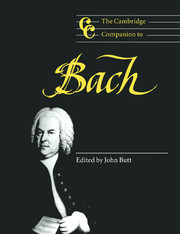Book contents
- Frontmatter
- Introduction
- Part I The historical context: society, beliefs and world-view
- Part II Profiles of the music
- 6 The early works and the heritage of the seventeenth century
- 7 The mature vocal works and their theological and liturgical context
- 8 The instrumental music
- 9 The keyboard works: Bach as teacher and virtuoso
- 10 Composition as arrangement and adaptation
- 11 Bachian invention and its mechanisms
- Part III Influence and reception
- Notes
- Select bibliography
- General Index
- Index of works
10 - Composition as arrangement and adaptation
from Part II - Profiles of the music
Published online by Cambridge University Press: 28 September 2011
- Frontmatter
- Introduction
- Part I The historical context: society, beliefs and world-view
- Part II Profiles of the music
- 6 The early works and the heritage of the seventeenth century
- 7 The mature vocal works and their theological and liturgical context
- 8 The instrumental music
- 9 The keyboard works: Bach as teacher and virtuoso
- 10 Composition as arrangement and adaptation
- 11 Bachian invention and its mechanisms
- Part III Influence and reception
- Notes
- Select bibliography
- General Index
- Index of works
Summary
At every period of his creative life Bach may be found altering, arranging and continuing to develop his own and other composers' works. For the young Bach, arranging other composers' works was a means of analysing and coming to terms with the various musical traditions that he was attempting to assimilate. Parody – the practice of re-using his own vocal works and providing them with new words in new contexts – became increasingly important to him during the Leipzig years 1723–50. His leadership of the local Collegium musicum from 1729 also resulted in a series of harpsichord arrangements of older concertos originally scored for solo melody instruments. And among the activities of his final decade, the compilation, completion and editing of earlier works occupies a not inconsiderable space: it is to this tendency that we owe collections such as the ‘18’, the ‘Schübler’ Chorales and the second book of The Well-tempered Clavier. Even more far-reaching revisions may be found in two instrumental works that were redrafted during the 1740s, namely, the Canonic Variations and The Art of Fugue. In consequence, both these works survive in characteristically different versions. Nor should we forget in this context Bach's completion, towards the end of his life, of his Mass in B Minor (a completion substantially based on the use of parody) and, perhaps most surprisingly of all, his recourse to the work of a younger contemporary in the form of Giovanni Battista Pergolesi's Stabat mater, which he rewrote as a vocal composition with new words, Tilge, Höchster, meine Sünden BWV 1083/243a.
- Type
- Chapter
- Information
- The Cambridge Companion to Bach , pp. 154 - 170Publisher: Cambridge University PressPrint publication year: 1997
- 15
- Cited by



